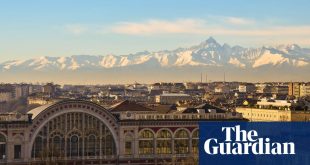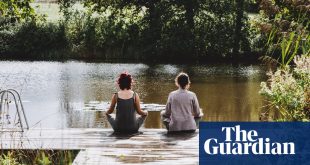Heading for the seafront from Blackpool North station, I passed gleaming new tramlines. Blackpool’s famous trams – confined to the promenade since the early 1960s – will soon be running inland again, and nearby hoardings boasted: “The renaissance of Blackpool is gathering pace.”
Good news about Blackpool is welcome, and rare. You can read all the indices of deprivation in Madelaine Bunting’s recent The Seaside, an excellent book, but the chapter on Blackpool is enough to make me feel guilty at always having had such a good time there.
Of course, you do have to brace yourself for sensory overload, and that was my mode as, overnight bag still in hand, I marched along the prom towards the tower. Entering the building at the base, I climbed the wide stairs, passing beautiful turquoise ceramics depicting underwater scenes. Occasionally, I glimpsed the riveted girders by which the tower is rooted to the prom, which are somehow unnerving, like scaly dinosaur legs amid the Victorian gentility.
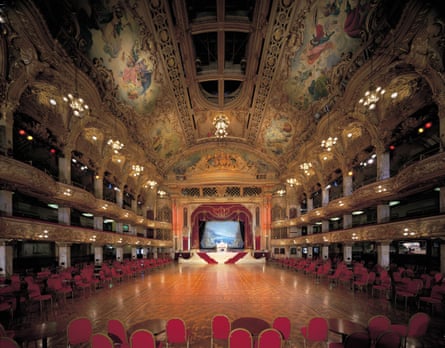
Entering the vast, gilded ballroom, I was confronted by the Fellini-esque vision disclosed there every afternoon. A white Wurlitzer organ was being played from the stage by a dapper man whose blazered upper half was very composed but whose feet were flying about as he touched the pedals. On the floor, couples of all gender combinations were performing a medieval-looking, courtly dance – a gavotte, I think. Spangly dresses sparkled in the softly golden illumination, as did every man’s shoes. My meal arrived: crustless sandwiches and carefully variegated small cakes. The organist was now playing a quickstep, and the vibration of the sprung floor sloshed my tea in its cup. The sweat on the dancers’ faces coexisted oddly with the great decorum of their moves.
Half an hour later, I was in the glass lift ascending the tower, which is rusty in parts, as though it had once been under the sea, and which culminates in a series of what look like large ornate birdcages, collectively known these days as the Tower Eye. From these, you survey the basic Blackpool offer: no harbour or cute coves but just a massive expanse of beach, giving way to an inscrutable sea. I looked directly down, at the bunker-like Coral Island amusement arcade that stands on the site of the old Central Station, which, until 1964, disgorged excursionists (sometimes 30 trainloads a day) directly on to the prom. Where the tracks entered the station, there is a very grey car park, but this is doomed, because the footprint of the old station is to be redeveloped – another aspect of the renaissance.
After leaving the tower, I sought directions to my hotel – the Imperial – from a woman serving at an open-fronted shop selling ice-cream, doughnuts and rock (and this being Blackpool, there is a whole genre of “adult rock”, as well as cannabis-flavoured candy floss). “It’s that way, lovey,” she said. “Just keep going along the prom,” and she detailed all the things I would pass en route, just to be as helpful as possible.
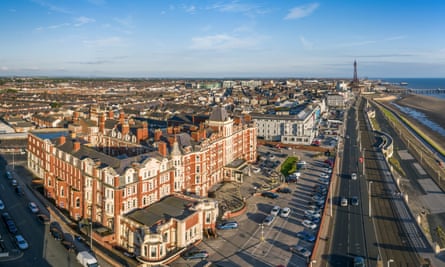
The Imperial is at the quieter, north end of town, where unfrequented colonnaded walkways overlook the sea wall. The hotel is stately, wood-panelled, an echo of Blackpool’s self-confident days – that is, the century or so after 1867, when it opened. Yes, the Turkish Bath is now closed; probably not many aperitifs, strictly so-called, are ordered in the Aperitif Bar. But the hotel retains its gracious dimensions. After a good, traditionalist dinner in the Palm Court – mushroom soup, fillet of stone bass, cheese and biscuits – I returned to the front, where Friday night jollities were contending with a soft, misty rain.
The blare of the Isley Brothers came and went as I passed the Soul Suite; then came Shenanigans Irish Bar (“Where every night is Saint Patrick’s night”), but the susurration of the sea was the dominant impression. The illuminated tower was one minute lime green, the next purple, then pink – reminiscent of all those sweets that don’t boast “no artificial colours”. To the south, a gathering sea fret occluded the entire Pepsi Max Big One rollercoaster except the red aeroplane warning light at the top.
The next day started grey. But the sun broke through just as I spotted one of the curvaceous green-and-cream 1930s trams on the prom, the modern fleet being supplemented by vintage vehicles throughout the year. They call at special stops and start their journeys from the Talbot Road depot, which is being redeveloped as Tramtown, a visitor attraction that will be part of the renaissance. I had booked for one of the Saturday morning tours of this museum-in-the-making. Only in Blackpool can the words “tram” and “flamboyant” coexist and the tour included viewings of such novelties as the 1960s “rocket tram”, where passengers sat at 45 degrees as though on a launchpad, and the “boat trams”, including the one modelled on the trawler from the Fisherman’s Friend lozenge packets.
after newsletter promotion

I walked south along the bright prom – which was busy, albeit not to the extent of the interwar years, when signs urged “Excursionists keep right” – and into the Pleasure Beach funfair, which resembles some mad sci-fi transport interchange, with people heading off in a variety of bizarre projectiles at all angles, sometimes upside down. But the classy and pristine fair is also a kind of museum, and I favour the older rides, like the Captive Flying Machines (1904) in which punters are whirled around in open-topped rockets. It’s peaceful and silent but at a certain point, anxiety kicks in: I’m tilting too far over! As for the Grand National coaster, it’s impressive that a ride made of wood in 1935 should remain poised just this side of out-of-control. Even the cockiest kids are silenced when alighting.
I drank an early evening white wine in The Albert and The Lion pub on the prom, converted from an art deco Woolworths and full of sunlight. Then I walked on, to the Grand theatre, for an enjoyable performance of The Mousetrap, although I was more interested in the venue itself, designed in 1893 by Frank Matcham whose brief was to create the prettiest theatre in Britain. I’d say he succeeded. Matcham was also the man behind the Tower Ballroom, and the Grand is like an annexe of that gold and powder blue dreamworld. The place was packed, the women, in long summer dresses, fanning themselves with their programmes, the men in pressed short-sleeved shirts.
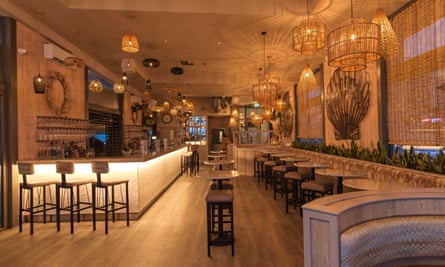
I had a late dinner in the Beach House, which occupies a stylish, skewed postmodern building, one of the few on the seaward side of the tram tracks. The music is loud, the cuisine excellent with a Mediterranean tendency. The sunroof was rolled back to show a starry sky. I might have been in Spain, although the delicate Victorian legs of the adjacent North Pier reminded me that I was somewhere altogether more unique and strange.
The next morning I rode along the prom through rain in a narrow wooden tramcar built in 1901 for Bolton council. I then mooched about until train time under a large colourful umbrella bought for £3 from a cheerful man who’d set up a shop on the forecourt of his well-kept guest house. He was obviously a great survivor, like the town itself, for which well-deserved better times seem to be just around the corner.
The trip was provided by visitblackpool.com. The Imperial Hotel has doubles from £72 B&B. Andrew Martin’s latest book Yorkshire: There and Back is published by Corsair (£12.99). To support the Guardian and the Observer buy a copy at guardianbookshop.com. Delivery charges may apply
 Top Naija News: Nigerian News, Breaking News Nigeria and World News Top Naija News is a daily news publication in Nigeria, delivering the latest breaking news in Nigeria and around the world.
Top Naija News: Nigerian News, Breaking News Nigeria and World News Top Naija News is a daily news publication in Nigeria, delivering the latest breaking news in Nigeria and around the world.
